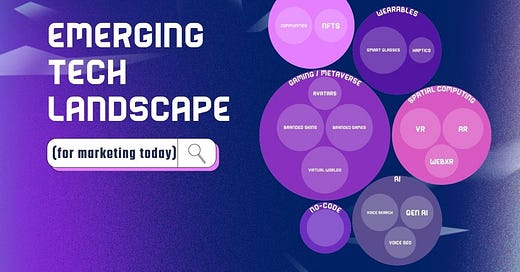The Future of Marketing: Navigating Emerging Tech in 2024 and beyond
Observations from my guest talk at NYU Emerging Technologies Marketing Class
I gave a guest talk for an Emerging Technologies Marketing Class at NYU this week. It was virtual but still so much fun. Samantha G. Wolfe (co-author of Marketing New Realities) is the professor. She asked me to speak to her students about my career and lessons learned from working with brands in emerging tech.
Wolfe and I had a nice conversation during my presentation about what constitutes the metaverse in 2024 and good examples of using emerging tech at the top of the marketing funnel. The top of the marketing funnel is what brands call the stage of building awareness of their product and what problems it solves. AR/VR, branded games, and virtual goods are examples of emerging tech brands that can be used today to market to their audiences in ways that resonate with them.
Some interesting observations preparing for my talk:
There is no funnel. Emerging tech is an experience that people are part of, not something they need to be guided through.
Brands know they need emerging tech in their marketing strategies but they’re not sure how to do it.
Augmented reality filters and lenses through social media apps or WebAR activations are the easiest emerging tech to use with people. They don’t have to think about it being AR and there are trackable metrics marketers are used to.
Brands are piloting emerging tech marketing projects, yet they expect immediate ROI
Emerging tech offers a chance to change our mindsets about how we think about customers. Let’s stop using “users” to describe the people who participate in branded experiences. They’re players, participants, and customers… although Sephora refers to their customers as “clients”. How can you change the way you call your customers?
Brands fall for hype tech. It went from the Metaverse to GenAI overnight. Metaverse experiences are still around, although many are empty spaces. Building branded metaverse experiences takes intention and time. If you’re hopping from one emerging tech trend to the next, you’ll fail.
Brands need to understand the culture of the virtual worlds and games in which they choose to build. A knowledge of gaming principles and best practices is a must.
If Roblox were a country, it would rank approximately 20th in the world above countries like the U.K., France, and Italy.
Marketing fundamentals like how you define your target audience, the 5 Ps, and how you define your brand apply to emerging tech.
Marketing fundamentals may be the same but emerging tech will change consumer behavior, like how they perceive your brand, and will create new segments for the type of consumer they are.
Marketing with emerging technologies isn’t just about keeping up with trends; it’s about creating meaningful experiences that resonate with people. Brands that use emerging tech should be prepared to move beyond traditional marketing funnels and instead view consumers as active participants in their journeys. By understanding and integrating the cultural nuances of the digital environments we engage with, brands can foster deeper connections with their audiences.
In my next post, I look forward to diving into the practical applications of these technologies in retail marketing, exploring how they can redefine the shopping experience and enhance consumer engagement.
Stay tuned!






